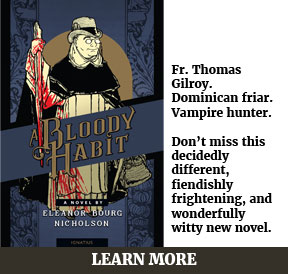![]()
The other day my six-year-old daughter said something very striking. I had asked my three children what kind of music they would like to listen to. She told me that she didn’t want to listen to classical right now, and requested pop music instead.
“Why?”
“Because classic music is so beautiful and sad that I feel too much and get tears. Rock music doesn’t make me feel very much.”
The idea of a beauty that is wounding, that makes you “get tears” made me think of something I had read before, but it was a few days before I found it again. In a 2002 address by then-Cardinal Joseph Ratzinger, he talked about how beauty in the arts is an essential pastoral issue, because the encounter with beauty is a form of knowledge that can lead to acceptance of argument for faith:
Being struck and overcome by the beauty of Christ is a more real, more profound knowledge than mere rational deduction. Of course we must not underrate the importance of theological reflection, of exact and precise theological thought; it remains absolutely necessary. But to move from here to disdain or to reject the impact produced by the response of the heart in the encounter with beauty as a true form of knowledge would impoverish us and dry up our faith and our theology. We must rediscover this form of knowledge; it is a pressing need of our time.
Starting with this concept, Hans Urs von Balthasar built his Opus magnum of Theological Aesthetics. Many of its details have passed into theological work, while his fundamental approach, in truth the essential element of the whole work, has not been so readily accepted. Of course, this is not just, or principally, a theological problem, but a problem of pastoral life, that has to foster the human person’s encounter with the beauty of faith. All too often arguments fall on deaf ears because in our world too many contradictory arguments compete with one another, so much so that we are spontaneously reminded of the medieval theologians’ description of reason, that it “has a wax nose”: in other words, it can be pointed in any direction, if one is clever enough. Everything makes sense, is so convincing, whom should we trust?
The encounter with the beautiful can become the wound of the arrow that strikes the heart and in this way opens our eyes, so that later, from this experience, we take the criteria for judgement and can correctly evaluate the arguments.
But beauty can also be used for evil. Ratzinger goes on to say “Falsehood however has another stratagem. A beauty that is deceptive and false, a dazzling beauty that does not bring human beings out of themselves to open them to the ecstasy of rising to the heights, but indeed locks them entirely into themselves… Who would not recognize, for example, in advertising, the images made with supreme skill that are created to tempt the human being irresistibly, to make him want to grab everything and seek the passing satisfaction rather than be open to others.”
He describes our current dilemma: “So it is that Christian art today is caught between two fires (as perhaps it always has been): it must oppose the cult of the ugly, which says that everything beautiful is a deception and only the representation of what is crude, low and vulgar is the truth, the true illumination of knowledge. Or it has to counter the deceptive beauty that makes the human being seem diminished instead of making him great, and for this reason is false.”
It’s very easy even as committed Christians to not take time to absorb beauty, whether it is in music or literature or the visual arts. We regard it has something extra, a superfluous aspect of life. But it’s an essential aspect of a fully human life; as Pope Francis reminds us in Laudato Si’, “By learning to see and appreciate beauty, we learn to reject self-interested pragmatism. If someone has not learned to stop and admire something beautiful, we should not be surprised if he or she treats everything as an object to be used and abused without scruple.” We should allow the arrow to strike our hearts; it can be essential in helping to transform our response to the demands of faith.
Read the entire 2002 address by the future Benedict XVI here on the Vatican website.
Image: detail from an Ethiopian icon pendant, early 18th century.






Michael P. De Santis
August 1, 2015 at 7:33 am
Thank you!!! May the Lord richly bless you, your crew, and families with heaven’s best blessings!!!
Sue
August 1, 2015 at 10:49 pm
When I attended a Church in Virginia, a few of the ladies had beautiful voices and would sing solo. A friend said “church is not a show time”…I disagreed with her, if God gave you a talent, you should give it back to Him. When I hear a beautiful voice in Church it brings me closer to God in my meditation.
Ignatius Press Novels | When It Comes to Marriage and Family, Stories Matter
April 8, 2016 at 3:03 pm
[…] a widespread impoverishment in society. We should be unafraid in saying these things are essential. And raising our families to appreciate these things will result in adults who are able to ground themselves deeper and be open to the beautiful without […]